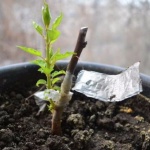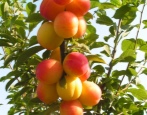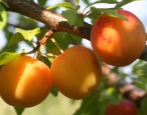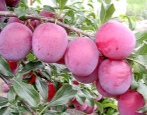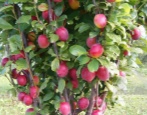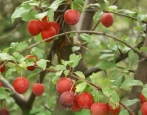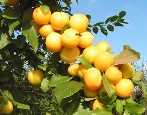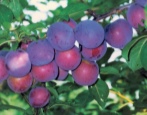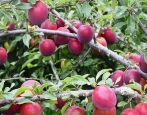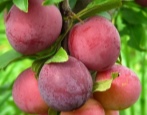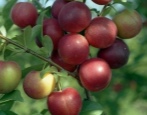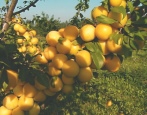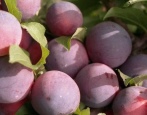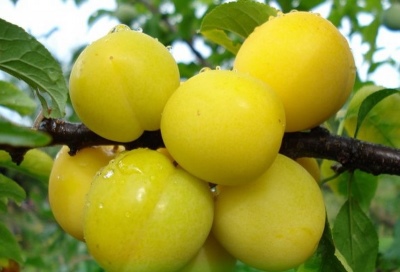
- Authors: G.V. Eremin, S.N. Zabrodina (Crimean experimental breeding station of the All-Russian Research Institute of Plant Industry named after N.I. Vavilov)
- Name synonyms: Prunus cerasifera Gek
- Appeared when crossing: Chinese plum Early x cherry plum Excellent student
- Year of approval: 1995
- Growth type: medium-sized
- Ripening period: average term
- Self-fertility: self-infertile
- Fruit size: large
- Yield: high
- Appointment: for canning, for fresh consumption
Among all varieties of cherry plum, yellow-fruited varieties are especially appreciated. One of the best in this category is the domestic large-fruited variety Gek (Prunus cerasifera Gek).
Breeding history
Cherry plum with the nostalgic Soviet name Gek, like the little hero of the wonderful story of Arkady Gaidar, was bred at the Crimean experimental selection station VNIIR, opened at the cannery, famous throughout the country. Back in 1937, in the village of Krymskaya, Krasnodar Territory, a test site for fruit crops was organized. In 1940 it was merged with a vegetable farm and an experimental station was created.
The authors of the variety were the leading employees: G.V. Eremin (later the head of the experimental station, academician of the Russian Academy of Sciences and the Russian Academy of Agricultural Sciences, professor of the Kuban University) and Zabrodina S.N. The originators received a patent for this selection achievement. The application for admission was filed in 1990, since 1991 variety trials have been carried out, and in 1995 the variety was included by the State Register in the list of allowed for cultivation in the North Caucasus region.
This variety is a representative of the so-called Russian plum (Prunus rossica) - a unique group of complex hybrids with large sweet fruits, which was created by Russian breeders.
Description of the variety
Cherry plum Gek is a large-fruited, high-yielding, unpretentious and relatively disease-resistant variety with an average late fruiting period. Forms a medium-sized tree with a flat-round crown on an even gray trunk with lenticels (textured convex points-formations on the trunk).
The shoots have a rich shade of anthocyanin, as the plant develops, they change the position of growth from vertical to horizontal. Leaves are oval, large, with shine. Fruits are yellow, with a waxy coating and sweet and sour taste. The variety is self-fertile.
Fruit characteristics
Outwardly, very attractive cherry plum fruits Gek have an ovoid shape, an average size of about 4 cm and a weight of 28-31 g. Some gardeners, thanks to careful agricultural technology and in the presence of favorable climatic conditions, achieve record indicators in 45-70 g. Sufficiently dense and elastic skin of a saturated bright -yellow color acquires a light pink blush with full ripeness. On the surface of the fetus, a lateral seam is clearly visible and a few subcutaneous points are visible, there is a characteristic and not too thick waxy coating.
The fine-grained yellow flesh is slightly dry, most often slightly juicy, the cut practically does not change color. Like most types of cherry plum, it is difficult to separate the bone from the pulp, especially if the fruit has not reached full ripeness.
Taste qualities
The sugar content in fruits is average - about 8.3%, vitamin C - just over 5%. Fragrant fruits gain sugar content well from sun exposure. The balanced sweet-sour taste makes this variety a versatile variety. Cherry plum Gek is suitable for fresh consumption, suitable for various preparations: juice, compotes, preserves, confiture. Some tasters have noted an apricot aftertaste.
Ripening and fruiting
This medium late variety can be harvested after July 15th. Signal fruiting occurs already at the 2nd year of the tree's life, and at 3-4 years they receive a full-fledged abundant collection. Huck bears fruit for 30-45 days, until the end of summer.
Yield
Cherry plum Gek consistently brings a high yield of 30-45 kg per adult tree. Shoots are densely covered with large golden fruits. Even the most ripe and overripe fruits do not fall off the branches. The variety has a good presentation, keeping quality and transportability.
Growing regions
This cherry plum has been grown for almost three decades in private gardens and large industrial plantings in the Russian North Caucasus. Despite the fact that zoning was not obtained in other regions, Huck is successfully planted and bred in the Lower and Middle Volga, in the Central Black Earth Region. The variety is widespread and popular in Ukraine.
Self-fertility and the need for pollinators
The variety is not self-fertile, it requires the proximity of cherry plum or Chinese plum varieties with the same flowering time. It begins to bloom early, in the first decade of April (depending on the region). A representative of the same hybrid group of diploid Russian plums, cherry plum Traveler, is ideal for the role of the pollinator.
Growing and care
A very simple care for cherry plum Huck is available even to a novice gardener. The tree is propagated by shoots, root cuttings, grafting on the stock. This cherry plum tolerates subzero temperatures well, and mulching of the root zone, insulation of the stem and the use of covering material will help to survive severe frosts and protect the tree from the wind.
There are nuances that will allow you to grow a healthy tree and get a good harvest.
- The time of planting seedlings. The choice of planting dates depends on the growing region: in the southern regions it is carried out in the fall, and in areas with more severe winters - in the spring.
- Landing scheme. For the tree to develop properly, it needs a space of about 3x4 m.
- Choosing a place. Cherry plum loves to grow on small slopes. Better to choose the southern or southwestern part of the site. In the lowland, cherry plum is placed on an artificially created small embankment. It is necessary to ensure that the root collar is not buried.
- Soil quality. The variety prefers fertile light soils with low to medium acidity. It is not recommended to place the tree where the groundwater is high (above 1.5 m).
- Watering. Huck has an average drought tolerance and only tolerates a short-term moisture deficit without problems. The tree requires water regularly, about 6 times a season, 15 liters per year of life. Abundant water-charging watering is carried out in the fall.
- Top dressing. In early spring and during the formation of ovaries - nitrogen, in the summer months - potash and phosphorus, in the fall - organic.
- Pruning. The growth of this cherry plum is quite intensive, therefore, the crown is thinned out, dried and affected branches must be removed.
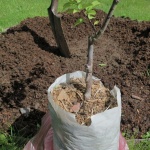
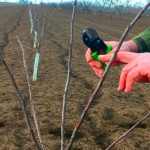
Disease and pest resistance
The variety has good immunity to a number of diseases of fruit trees. With thickening of the crown and prolonged damp weather, it can be affected by gray rot.
Timely insecticide treatment will provide the necessary protection from pests (for example, the plum roll).

